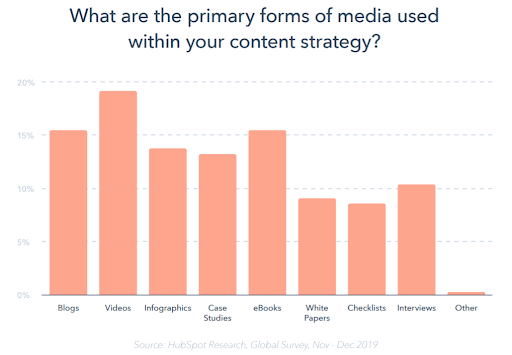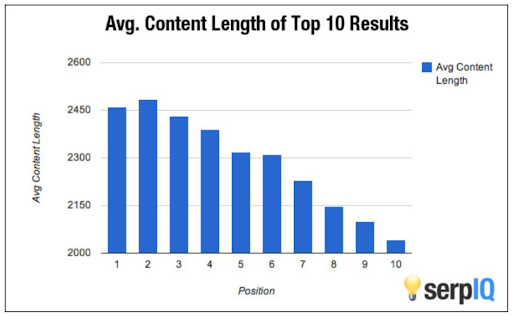According to HubSpot’s 2020 State of Marketing Report, blogging is one of the top three content marketing strategies for businesses, following only Video and eBooks. For many businesses, blogging is the foundation of their content strategy, with SEMrush reporting that blog posts are more effective than email, eBooks, and white papers.
Source: Hubspot Research Global Survey, Dec 2019
The benefits of regular blog writing
Regular blog writing is a time consuming and often painstaking process, but it’s one that pays off the time invested, particularly when you post high quality, relevant content. Marketers, bloggers, and business owners recognize this. In 2020, one study found that over half of 1200 businesses surveyed reported their blog delivered strong marketing results. Since strong results can be subjective based on your business and your goals, here’s a broad list of blogging benefits:
- More website traffic and leads: This is particularly true with longform posts (2000+ words). Long-form content generates 8x more pageviews, 3x more social media shares, and 9x more leads than short-form content.
- Blogging fuels social media presence and engagement. Blog posts can be shared on social media channels like LinkedIn, Facebook, and Twitter, drawing new users to your website while keeping your social media presence active and engaging users who follow your business accounts.
- Blogging helps with SEO. Blogging feeds directly into your SEO strategy by addressing several Google ranking factors around content, particularly longer articles. In-depth longform content correlates with higher rankings in search results. High quality content helps Google’s algorithm connect what you’re saying to what users are searching for even if the keywords don’t match exactly. It helps search engines distinguish words that have more than one meaning (e.g., Apple Computer versus apple orchard). Google also favors content recency and this is particularly true for time-sensitive searches.
The first rule of blogging is: keep at it.
The key thing to remember is that regular, consistent blogging is the foundation for an effective content strategy. Our own blog traffic increased by 126% from February 2020 to February 2021, even amid a global pandemic. That’s because we kept blogging each month, multiple times per month. Overall website traffic increased by 108% during the same time and this is all without spending a dime on advertising.
Tips for more successful blogging
There were nearly 32 million bloggers in the US in 2020 representing over 500 million blogs. It’s an obvious content tactic—a tool that many businesses are already using. But as with most tactics, some people achieve greater success than others.
Blogging with intention and a clear-cut strategy can help your blog perform better. By “perform” we mean generate qualified inbound traffic and leads. A study of over 1200 bloggers found that high performing bloggers did a few things differently and were more likely to report success.
High performing bloggers were more likely to:
Write longer posts—specifically, posts of 2000 or more words. This is consistent with data from serpIQ which correlates content length to higher search positioning, as demonstrated in the following chart:
Source: serpIQ
The above chart shows that longer content of around 1800 to 2500 words ranked in the top three positions in Google. The sweet spot seems to fall at about 2400 words.
Used more visuals—High performers featured 7+ images in their blog posts and used video. Video has been shown to increase engagement, with visitors spending 2.6x more time on pages with video versus pages without.
Created high quality content—High performers spent 6+ hours writing each post, drafted multiple headlines (7 or more), and worked with multiple editors to ensure all posts were high quality. They also tended to collaborate with influencers for most of their articles, which is something to strive for when creating longform content that is widely shared.
Published often—High performers published blog posts multiple times per week or more. In fact, daily bloggers reported the strongest results while those who published monthly or several times per month had the poorest results.
Creating high quality longform content multiple times per week is time consuming, so it’s worth mentioning that in 2020, the average blog post was about 1300 words. This is up from roughly 800 words in 2014. You can make every post count (regardless of length) if you take the time to perform keyword research, understand what your audience wants (e.g., intent), and familiarize yourself with Google’s ranking factors.
Your blog needs a strategy
SEMrush reports that 84% of marketers have a content marketing strategy. Focusing on strategy—the what, why, where, when, and how of creating content—forces you to consider how your blog fits into your overall marketing goals.
Your blog content plays multiple roles, serving as the foundation for SEO, social media, and inbound marketing. The company blog must be more than an afterthought. As such, it’s important that everyone within your organization is on board with the content strategy and can contribute to a unified content approach that drives leads, sales, and revenue.
Over 75% of content marketing teams are comprised of less than 3 people, yet these teams do a lot—including planning, writing, editing, posting, and sharing content. Coordinating your content marketing approach is important to support your content team. Technology is making it easier for small content teams to manage larger outputs of content. Tools like SharpSpring, a marketing automation platform that we use internally and with some of our clients, enable you to do more with your blog.
For example, you can automate the process of emailing blog posts to your clients and prospects using personalization filters that ensure the most relevant content is seen by the most relevant recipients. SharpSpring also enables users to schedule and push social media posts, further pushing the content on your blog out to your network.
It is vital to note that crafting engaging and high performing blogs requires an ongoing investment in the form of an experienced blog writer. Many companies make the mistake of assuming just anyone on their team can create content, but it is a mistake to devalue high quality writing. Relying on a team member who is talented in other ways may feel like the right move in terms of fact recall and personal insight, but communicating to external audiences and repackaging those facts and insights is an art worthy of its price tag.
A word about monitoring blog performance
As with any marketing tactic, you should keep track of your blog’s performance and its impact on your bottom line. Blog posts are not considered paid media, but you can still set goals and KPIs for your blog. Here are a few to consider:
- Monitor page views, users, and leads generated from your blog.
- Track search engine rankings/positioning for your blog posts and website.
- Track sales/revenue over time (this may or may not directly correlate with a specific blog post, but rather, with an overall increase in traffic and visibility).
You should also monitor the traffic to your blog content to see what posts are resonating the most with your visitors. Certain posts will invariably become evergreen, resonating with visitors year after year (our second most popular post in 2020 was a piece about typography and typefaces that we wrote in 2014!) Once you understand what does or doesn’t work, you can refine and revise your blog writing approach using more intention and less guesswork.
Contact us to discuss how we can help you create a blog strategy that focuses on targeting the most relevant topics and keywords for your business.


